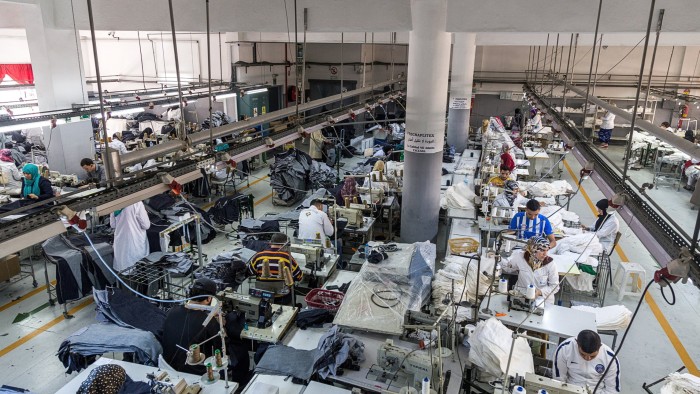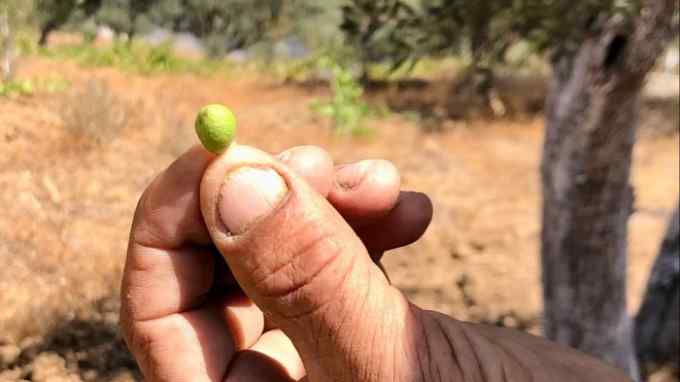Textiles weave their way into Moroccan export bounceback

Roula Khalaf, Editor of the FT, selects her favourite stories in this weekly newsletter.
After the severe disruptions of Covid, Morocco’s textile and clothing industry is flourishing again.
The sector is firmly focused on exports and, in 2022, these jumped by a fifth year-on-year to reach a record 44bn Moroccan dirhams ($4.25bn). Despite fierce international competition, the country is now Europe’s eighth-largest textile and clothing supplier.
Even after the pandemic disrupted manufacturing and global demand, Morocco’s textiles industry still accounted for 15 per cent of industrial GDP in 2021 and 11 per cent of its exports, according to a recent report by the International Finance Corporation, part of the World Bank.
So-called “fast fashion” accounts for 52 per cent of production. Predominantly, this involves the assembly of designs provided by wholesale and retail customers using fabrics, yarn and other accessories imported from countries led by Turkey — although there is increasing diversification.
“Its proximity to southern Europe — specifically Spain — is a huge advantage given the speed of supply in fast fashion,” says Martin Stone, partner at Zenobia Intelligence, a business consultancy focused on the Middle East and north Africa. “Moroccan textiles make up most of brands like Zara and Mango’s garment supplies.”
However, EU rules on what counts as “substantive stages of production” — depending on the sourcing of materials — constrain what can be exported free of duties in the Pan-Euro-Med trading zone.
As well as its proximity and its logistical links to European end markets, the Moroccan textile industry also offers competitive labour costs, short lead times, and flexibility for small and medium orders, through its dedicated textile technology parks and industrial zones.
It has had some significant ups and downs in past decades, though.
In the 1990s, trade boomed when cheap labour was plentiful. But, then, with the rise of trade with post-Soviet eastern Europe, Romania’s textile industry — in particular — took much of the export market from the Kingdom. When customers such as the British retailer M&S left Morocco in the 2000s, factories closed.
However, Morocco’s fortunes as a centre of clothing manufacturing changed again when Romania entered the EU as a full member. Many of that country’s workers gradually switched to other, better-paying industries, helping restore the cost competitiveness of Morocco’s textile trade.
More recently, the Covid pandemic has severely disrupted Morocco’s gradual fightback. Exports from the sector fell from Dh37bn ($3.6bn) in 2019 to under Dh30bn ($2.9bn) in 2020. They then clawed their way back to near pre-pandemic levels before a surge in 2022 to the record Dh44bn.
Today, the textile sector today has 1,600 companies registered and, last year, they reached a turnover of Dh60bn ($5.6bn), according to the Moroccan government. Exports accounted for Dh40bn ($3.9bn) of this total, compared with Dh36bn ($3.5bn) in 2018.
In July 2023, Ryad Mezzour, Morocco’s minister of industry and trade, told the country’s House of Representatives that there were 173 investment projects in the sector under way and that Morocco’s ambition was to boost exports further to Dh50bn a year.
For the country, the textile sector is an essential source of foreign exchange, as well as a key employment provider. Figures differ but, according to the Moroccan Association of the Textile and Apparel Industries (AMITH), the industry employs around 160,000 workers, most of whom are women.
Registered factories are frequently inspected by the government and also audited by buyers to ensure acceptable working conditions and production standards prevail. However, the sector has been embarrassed by the operation of illegal factories, based primarily around Tangier. In 2021, a factory owner was jailed after 28 workers died in the flooding of an illegal clothes factory concealed in a villa basement. It had been operating in the city for more than 20 years.
For textile business owner Jorgin Poli — whose company supplies retailers including River Island and Monsoon, and who has been working in Morocco for 25 years — the long-established skill of the workforce is essential to the sector’s success. “They have a heart for the business,” he says. “The Moroccan workforce is very flexible: 95 per cent of our workers are women, and a lot of them are mothers but, even so, they will stay and work late to make sure the orders go out.”
Even so, labour shortages are an issue for the factory owners, as better wages in other sectors make some workers look elsewhere. Other industries have become more popular among the young. For example, jobs in the expanding car industry are sought after as foreign investment comes in and salaries are raised.
Morocco’s average textile factory wage is between Dh2,000 ($195) and Dh4,000 ($390) per month. This compares with an average of Dh7,200 ($700) per month for a car factory worker.
Textile industry leaders remain concerned about its future and its rivals. China dominates world production, but Turkey is the rival that Morocco is targeting. The manufacturing of clothing for both local and export markets in Morocco uses large quantities of textiles sourced from Turkey. Fabrics, yarns and other raw material exports to Morocco increased by 30 per cent in the first six months of 2022. Also, in terms of local consumer sales, it is Turkish rather than domestic products that are omnipresent in Moroccan shops and markets.
Factory owners want to be able to use more local Moroccan materials and accessories. Recently, the government has been investing in developing weavers and other raw material producers in the supply chain, but there is still some way to go.
There are also new markets to be developed. “The industry is going to grow,” says Zakarraya Boukhari, managing director of BMS Clothing, which supplies retailers including Bravissimo, Evans, Bon Marche, M&S, Mothercare, John Lewis and River Island.
“[But] we need to invest more in new technology, and we need government help to access new research and textiles and to participate in trade fairs like London and Paris,” he says. The sector also needs to search out new sales territories, Boukhari argues. “We should look to Africa. It is a new market, and it is the future market.”

Comments